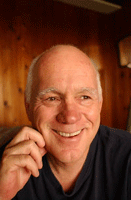The Biggest Liar by Ken Kuhlken


Ken's Bio
After borrowing time from his youthful passions, such as baseball, golf, romance, and trying to make music, to earn degrees in literature and writing from San Diego State University and the University of Iowa, Ken got serious (more or less).
Since then, his stories have appeared in Esquire and dozens of other magazines, and anthologies, been honorably mentioned in Best American Short Stories, and earned a National Endowment for the Arts Fellowship. He has been a frequent contributor and a columnist for the San Diego Reader.
With Alan Russell, in Road Kill and No Cats, No Chocolate, he has chronicled the madness of book promotion tours.
Ken’s novels are Midheaven, chosen as finalist for the Ernest Hemingway Award for best first novel and the Tom Hickey California Century series:
The Loud Adios, San Diego and Tijuana, 1943 (Private Eye Writers of America/St. Martin’s Press Best First PI Novel); The Venus Deal, San Diego, Mount Shasta, and Denver, 1942; The Angel Gang, Lake Tahoe and San Diego, 1950; The Do-Re-Mi, rural Northern California, 1972 (a January Magazine best book of 2006 and finalist for the 2006 Shamus Award); The Vagabond Virgins, rural Baja California, 1979; The Biggest Liar in Los Angeles, Los Angeles, 1926 (coming in May 2010).
Interview:
Marilyn:
When did you know you wanted to be a writer?
Ken: As far back as I can remember I imagined myself writing stories. We lived with my maternal grandma, an artist who would turn Les Miserables, or The Last Days of Pompei, or The Hunchback of Notre Dame into a childrens’ story and tell it to me and my cousins. Her stories were so real, in some ways they felt more real than my life.
Marilyn: What led you to write The Biggest Liar?
Ken: My dad grew up in Los Angeles. When he was young, Sister Aimee Semple McPherson made lots of headlines with her evangelism and healing services. I grew up hearing of her and when the series I write called for a book set in the 1920s, she came to mind. I like to explore religion and its effect on people. So I decided to link the story somehow to Sister Aimee. I started the research by reading about her, and that led me to other folks who shaped the era, such as William Randolph Hearst and Harry Chandler.
Marilyn: The research must've been exciting. Do you want to tell my blog readers something about that process?
Ken: When I learned the Ku Klux Klan had made a comeback in the early 1920s, sparked by the film Birth of A Nation, the image of a lynching came to mind. And reading about the Azusa Street Mission, a multiracial church that is called the birthplace of the modern Pentecostal movement, made me want to explore the racial attitudes of that time and place.
Tom Hickey needed to enter the story even though he was a bandleader at the time, not a cop. From that, the idea of a cover-up developed. And I had known long ago that Tom had attended the Azusa Street mission as a small boy, so I decided he knew the murder victim from the mission.
Since Hearst published The Examiner and Chandler published The Times, for a cover-up of a murder to happen in 1926 Los Angeles, those two would be involved, as would police chief Two Gun Davis.
I read a quote recently, about stories being not so much written as distilled. That’s how The Biggest Liar in Los Angeles happened, as if I was sorting out history to find the story that already existed.
Marilyn: What's been the most exciting thing so far about having finished your book?
Ken: Taking a break for a trip with Zoë, my seven-year-old.
Marilyn: What are your future plans?
Ken: The series calls for book set in most every decade in the 20th century. In my view, during those years, California transformed from a promised land into a prototype for much of the world. So I’m working on a book of the 1930s, about the Depression and the film industry and Tom Hickey learning what became of his father. And I’ve made notes for a book of the 1950s, set amongst the San Francisco North Beach jazz clubs and beat hangouts.
Marilyn: Where can we find your book?
Ken:
The Biggest Liar in Los Angeles came out simultaneously in hardback, trade paper, large print, and audio. It should be available at any library or online source. Any bookstore that doesn’t carry it can order it. My website links to some independent booksellers. www.kenkuhlken.net
Marilyn: I'm really interested in this book as my mom and aunt went to Aimee Semple McPherson's church when they were teenagers. Thank you, Ken, for this great interview.


Comments
Jean
Yes, she disappeared, and she has been called to stand before the grand jury who is considering charging her with fraud, during the week or so in which The Biggest Liar in Los Angeles is set.
I'll be the book will jog your memory. Let me know, at ken@kenkuhlken.net